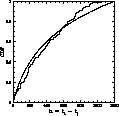There are many ways to describe periodic signals (Cuypers 1997). Most of the proposed methods are valid for rather strictly periodic signals: they are not very efficient when there is not a full conservation of the phase or of the amplitude. We may cite the following methods: "string" (Renson 1978), analysis of variances (Schwarzenberg-Czerny 1989), Fourier (Deeming 1975; Ferraz-Mello 1981; Babu & Feigelson 1996). Fortunately there are other methods which are better adapted to nearly periodic signals. The wavelets (Foster 1996), the autocorrelation (Bartholdi 1988; Edelson & Krolik 1988) methods and finally the structure function (Hughes et al. 1992), or variogram. These methods are obviously linked to each other. The last one is appropriate for our situation, as will be shown.
In order to describe a pseudo-periodic signal, we introduce the
concept of variogram. Let us consider a time series
![]() :
: ![]() , where D is a subset of
, where D is a subset of ![]() . We
can think of m(t) as the magnitude of a star at time t.
Suppose that the signal m(t) can be decomposed into the sum
of a deterministic part,
. We
can think of m(t) as the magnitude of a star at time t.
Suppose that the signal m(t) can be decomposed into the sum
of a deterministic part, ![]() , plus a stochastic part, the
noise. Assume that this series satisfies the following hypothesis
, plus a stochastic part, the
noise. Assume that this series satisfies the following hypothesis
![]() (a)
(a)
Var![]() (b)
(b)
where ![]() is the variogram, which can be used in
practice in order to study the
periodicity of the time series.
is the variogram, which can be used in
practice in order to study the
periodicity of the time series.
An interesting variogram that exhibits negative correlations caused by periodicity of the series is the wave (or hole effect) variogram (Cressie 1993) given by:

Note that a strictly periodic signal would show a periodic variogram defined by Journel & Huijbregts (1978):

Consider the series of differences at lag h defined by
v(h)=m(t+h)-m(t). Let ![]() be a sample
of a time series, and
be a sample
of a time series, and ![]() be the
corresponding sample of differences at lag h, where
be the
corresponding sample of differences at lag h, where
![]() :
: ![]() and Nh is the cardinality
of N(h).
The classical variogram estimator proposed by Matheron (1962),
based on the method-of-moments, is
and Nh is the cardinality
of N(h).
The classical variogram estimator proposed by Matheron (1962),
based on the method-of-moments, is

In the context of scale estimation, Rousseeuw & Croux (1992, 1993) have proposed a simple, explicit and highly robust estimator, called QNh, which is defined by

Using the previous definitions, Genton (1998) defines a highly robust variogram estimator as
![]()
![\begin{figure}
\hspace*{5mm}\mbox{
\subfigure[]{
\psfig {file=ds8030f2a.eps,hei...
...subfigure[]{
\psfig {file=ds8030f2b.eps,height=80mm,width=80mm}
}
}\end{figure}](/articles/aas/full/1999/08/ds8030/Timg31.gif) |
Figure 2: Diagram of pairwised differences. a) regular time sampling, b) irregular sampling for the star HIP 111771 |
Structure functions are used in AGN studies (Hughes et al. 1992). Apparently this goes well with the signals they want to study, because they are mainly interested in the slope of the rising curve of the structure function which gives information in the frequency domain (Paltani 1996). However for periodic signals, the oscillations may be diminished in their analysis. We are left with the difficulty of the choice of the binning and of the width of the bins. A too narrow width would have the disastrous effect to have too little measurements in a bin, whereas a constant binning can be too large for short periods and smears out the periodic behaviour. This is the reason why we choose to have a binning linked with the period investigated. Denote by

 |
||
 |
Figure 3: Empirical cumulative distribution function (CDF) of the lag differences for the star HIP 111771, and logarithmic approximation F(h) (smooth line) of the empirical CDF |
The remaining problem is the choice of the lags, i.e. the position of the bin location. If one chooses equidistant lags, there would be too many bins for large lags, and too few for small lags. Therefore, the distribution of the lags is a crucial question. Figure 3 represents the empirical cumulative distribution function (CDF) of the lags of the star HIP 111771, and indicates that a logarithmic scale of the lags

is a satisfactory approximation. Other stars have also been
analysed and the same approximation can be used for most of
them. Note that the greatest available lag is h=1200, and we
set F(0)=0 and F(1200)=1. In consequence, we adopt the
choice of lags ![]() such that
such that
![]() are equidistant on the interval
[0,1]. The number k of lags must be chosen such that a good
temporal resolution is achieved (for instance, k=90 is a
typical value with Hipparcos time sampling).
are equidistant on the interval
[0,1]. The number k of lags must be chosen such that a good
temporal resolution is achieved (for instance, k=90 is a
typical value with Hipparcos time sampling).
Another approach in the choice of the lags consists in computing quantiles of the empirical distribution of each star. The advantage of this method is its adaptability to the particular sampling of each star, whereas the former one was global. Moreover, lags are defined only when new data points are present. The drawback is that it provides clumped bin locations.
Copyright The European Southern Observatory (ESO)